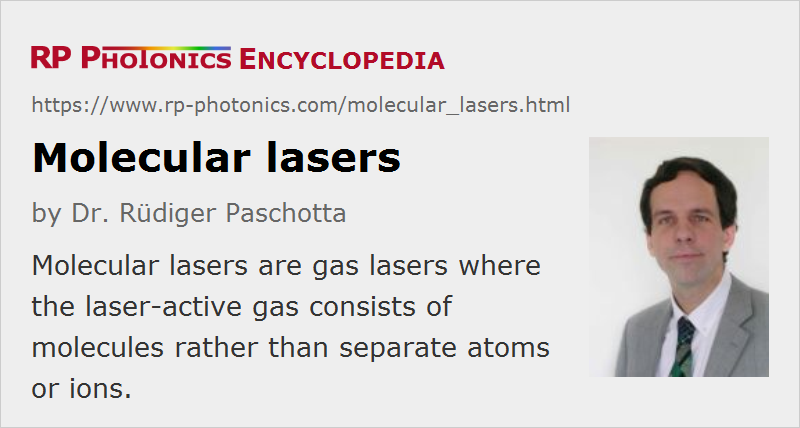Molecular Lasers
Definition: gas lasers where the laser-active gas consists of molecules rather than separate atoms or ions
More general term: gas lasers
German: Moleküllaser, Molekül-Gaslaser
How to cite the article; suggest additional literature
Author: Dr. Rüdiger Paschotta
Molecular lasers are gas lasers where the laser-active constituents are molecules rather than separate atoms or ions. Examples for such molecules are CO2 (carbon dioxide), CO (carbon monoxide), N2 (nitrogen), HF (hydrogen fluoride), DF (deuterium fluoride), NH3 (ammonia) and CH3OH (methanol). One exploits excited states of such molecules which can involve not only a purely electronic excitation (as of atoms or ions) but also vibrations and oscillations of the molecules. In many cases, the excitation energies are relatively small, leading to laser emission with long wavelengths in the mid or far infrared spectral region. There can be a substantial number of rotational–vibrational lines on which such a laser can be operated (→ vibronic lasers); single-line emission may require the use of an intracavity bandpass filter. If the pressure is relatively high, the different lines may overlap due to pressure broadening, resulting in a larger gain bandwidth.
The nitrogen laser is an example for a short-wavelength molecular gas laser, emitting ultraviolet light e.g. at 337.1 nm. The same holds for excimer lasers, which can also be called molecular lasers; in that special case, the molecules decay during the laser process.
There are different ways of pumping molecular gas lasers:
- Many molecular lasers are electrically pumped with a gas discharge (partly using radio frequency excitation), and sometimes with energetic electron beams. The most prominent example with gas discharge pumping is the CO2 laser, which can produce many kilowatts of output power with high beam quality and a power conversion efficiency which (as a consequence of a favorable excitation pathway) is at least substantially better than that of many other gas lasers. Also, excimer lasers are electrically pumped.
- For some molecules, chemical pumping is an option (→ chemical lasers). Here, the excited molecules, supplying the needed energy for laser operation, are generated in an exothermic chemical reaction. For example, hydrogen fluoride lasers (HF lasers) and deuterium fluoride lasers (DF lasers) utilize the combustion of ethylene in nitrogen trifluoride, followed by the injection of helium and hydrogen (or deuterium) in a facility which has some similarities to a rocket engine. That technology has the potential to provide enormously high output powers (sometimes several megawatts) for military applications like destroying rockets; chemicals can store substantial amounts of energy and release them quite quickly.
- In some cases, optical pumping is used. For example, the output of a CO2 laser can be used for pumping an ammonia (NH3) laser, and high-power ammonia lasers can also be pumped with HF lasers. Some molecular lasers have been pumped with laser diodes.
Questions and Comments from Users
Here you can submit questions and comments. As far as they get accepted by the author, they will appear above this paragraph together with the author’s answer. The author will decide on acceptance based on certain criteria. Essentially, the issue must be of sufficiently broad interest.
Please do not enter personal data here; we would otherwise delete it soon. (See also our privacy declaration.) If you wish to receive personal feedback or consultancy from the author, please contact him e.g. via e-mail.
By submitting the information, you give your consent to the potential publication of your inputs on our website according to our rules. (If you later retract your consent, we will delete those inputs.) As your inputs are first reviewed by the author, they may be published with some delay.
Bibliography
| [1] | O. R. Wood, “High-pressure pulsed molecular lasers”, Proc. IEEE 62 (3), 355 (1974), doi:10.1109/PROC.1974.9429 |
| [2] | I. Mukhopadhyay and S. Singh, “Optically pumped far infrared molecular lasers: molecular and application aspects”, Spectrochimica Acta Part A 54 (3), 395 (1998), doi:10.1016/S1386-1425(97)00230-8 |
| [3] | B. Wellegehausen and W. Luhs, “Diode-pumped CW molecular lasers”, Appl. Phys. B 122 (5), 133 (2016), doi:10.1007/s00340-016-6409-9 |
See also: gas lasers, mid-infrared laser sources, excimer lasers
and other articles in the category lasers
 |



If you like this page, please share the link with your friends and colleagues, e.g. via social media:
These sharing buttons are implemented in a privacy-friendly way!